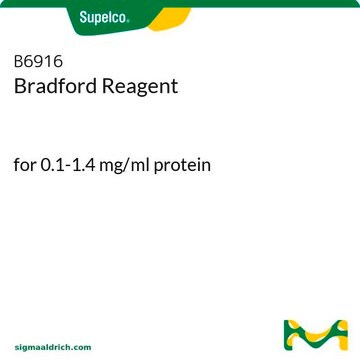The dry powder form allows for the preparation of Congo Red for various uses. The recommended dry dye for ordering is C6277 is currently undergoing BSC certification. Congo Red is a dye used for various staining procedures, mostly for staining of amyloid.
C6277
Congo Red
Dye content, ≥85%, certified by the Biological Stain Commission, powder
Synonyme(s) :
Congo Red 4B, Cosmos Red, Cotton Red B, Cotton Red C, Direct Red 28, Direct Red R, Direct Red Y
Sélectionner une taille de conditionnement
Sélectionner une taille de conditionnement
About This Item
Produits recommandés
Nom du produit
Congo Red, certified by the BSC, BioXtra
Agence
certified by the BSC
Gamme de produits
BioXtra
Forme
powder
Composition
Dye content, ≥85%
Technique(s)
microbe id | staining: suitable
Pf
>360 °C (lit.)
Solubilité
H2O: 10 mg/mL
Application(s)
diagnostic assay manufacturing
hematology
histology
Température de stockage
room temp
Chaîne SMILES
[Na+].[Na+].Nc1c(cc(c2ccccc12)S([O-])(=O)=O)\N=N\c3ccc(cc3)-c4ccc(cc4)\N=N\c5cc(c6ccccc6c5N)S([O-])(=O)=O
InChI
1S/C32H24N6O6S2.2Na/c33-31-25-7-3-1-5-23(25)29(45(39,40)41)17-27(31)37-35-21-13-9-19(10-14-21)20-11-15-22(16-12-20)36-38-28-18-30(46(42,43)44)24-6-2-4-8-26(24)32(28)34;;/h1-18H,33-34H2,(H,39,40,41)(H,42,43,44);;/q;2*+1/p-2/b37-35+,38-36+;;
Clé InChI
IQFVPQOLBLOTPF-HKXUKFGYSA-L
Vous recherchez des produits similaires ? Visite Guide de comparaison des produits
Actions biochimiques/physiologiques
Adéquation
Mention d'avertissement
Danger
Mentions de danger
Conseils de prudence
Classification des risques
Carc. 1B - Repr. 2
Code de la classe de stockage
6.1C - Combustible acute toxic Cat.3 / toxic compounds or compounds which causing chronic effects
Classe de danger pour l'eau (WGK)
WGK 3
Équipement de protection individuelle
Eyeshields, Gloves, type P3 (EN 143) respirator cartridges
Faites votre choix parmi les versions les plus récentes :
Déjà en possession de ce produit ?
Retrouvez la documentation relative aux produits que vous avez récemment achetés dans la Bibliothèque de documents.
-
looking for Congo Red stain, the one used in histopathology, but not sure which of the options is the best.
1 answer-
Helpful?
-
-
What is the Department of Transportation shipping information for this product?
1 answer-
Transportation information can be found in Section 14 of the product's (M)SDS.To access the shipping information for this material, use the link on the product detail page for the product.
Helpful?
-
-
Why does the SDS for Congo Red list carcinogen as an OSHA hazard, (Section 2) but in Section 11 on carcinogenicity, it states that there is no component identified as a carcinogen?
1 answer-
The reason that there is not an OSHA listing for carcinogens on most of SDS that have a hazard of a carcinogen hazard is because that section of the SDS is specifically for the OSHA regulated carcinogens, also referred to as the OSHA 13. Congo red at this time is not specifically called out as a carcinogen by the other 3 Organizations listed (IARC, NTP, ACGIH) either. Congo red is listed by the European Classification Labeling & Packaging (CLP) Regulation (which is a pretty definitive guide for hazard classification), as a carcinogen. No other organizations have had the time to classify this material at this time. This is why it is only listed as a carcinogen in section 2 and in section 15.
Helpful?
-
Active Filters
Notre équipe de scientifiques dispose d'une expérience dans tous les secteurs de la recherche, notamment en sciences de la vie, science des matériaux, synthèse chimique, chromatographie, analyse et dans de nombreux autres domaines..
Contacter notre Service technique








